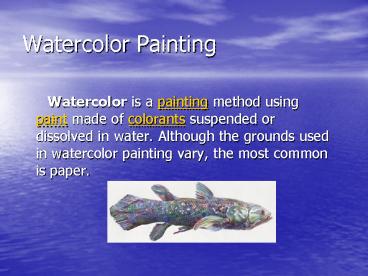Watercolor Painting PowerPoint PPT Presentation
1 / 21
Title: Watercolor Painting
1
Watercolor Painting
- Watercolor is a painting method using paint
made of colorants suspended or dissolved in
water. Although the grounds used in watercolor
painting vary, the most common is paper.
2
Layering-Superimposed Wash
- This is one of the more important
techniques in watercolor painting and it takes
some practice to master the technique. You will
be painting values of color by layering the same
color over an already painted surface. You MUST
allow the proceeding layer to be completely dry
before applying the second, third, fourth,
layers.
3
Wax
- Draw an image or design using both a
light and dark crayon. When the area has dried,
apply a watercolor wash and note how the two hues
are affected by the watercolor.
4
Sponging
- Mix a water color and dip a course sponge
into the paint. Create texture by sponging the
color in the desired area.
5
Flat Wash
- The technique is used when a surface is to
have an even (same) color over the surface of the
paper. Wet the paper with water and load brush
with water and pigment (color) and flood wet
surface with one flat color.
6
Acrylic over Watercolor
- Lay down a wash of light colored watercolor
paint. When completely dried, paint an image or
design over the wash with acrylic paint. Water
color is transparent and acrylic paint is opaque.
7
Maskoid
- A technique when you want to preserve
white or an area or color as you apply new and
more areas of color. The product used is called
maskoid. Add some soap to a brush. Paint
maskoid over the areas you want to stay white.
Clean the brush!! When maskoid has dried, paint
a watercolor wash over the maskoid. When paint
has dried, remove maskoid by rubbing it with your
finger.
8
Texture with Gesso
- Apply gesso to paper, allow it to dry, then
paint a colored wash over the top.
9
Scratching
- After watercolor paint is dry, use a scratch
tool to scratch away the surface creating
texture.
10
Collage
- Collage materials can be anything that can
be adhered to the painting surface to create an
effect. Examples tissue paper, fibers or
fabrics, buttons, etc. Glue down the material
using Elmers glue.
11
Wet on Wet
- This technique is one of the most used and
unique types of water color painting. To do this
technique, paint your paper surface with water or
a very light color, when the surface is still
very wet drop in a brush-full of darker color,
the surface must be quite wet to get a successful
blending of the two. Leave it alone or
manipulate lightly. You can add several colors
for an even better effect.
12
Dry Brush
- This technique is used to suggest textural
detail. Add pigment to a dry brush and wipe it
across paper toweling. Rapidly skimming the
surface of the paper with the brush putting
traces of color that creates the effect of
texture.
13
Splatter
- Load your brush with paint and a little
water and tap the handle on the handle of another
brush, allowing a series of spots to appear on
the paper. This also can be done with a
toothbrush.
14
Lifting out with Blotter Paper
- Paint the surface of the paper with a strong
dark color then take a clean, dry brush and
remove an area of color. Blotting paper can
also be used. If you are using good quality
paper this can be repeated.
15
Watercolor Pencil
- Draw or shade with watercolor pencils
then add water with a brush. Or dip the pencil
in water and create color. Great for detail and
texturing.
16
Pen and Ink
- After applying watercolor paint, use a
black pen or permanent marker to enhance or
outline the colors after the paint has dried.
17
Graded Wash
- This is most often used when painting a
sky from dark to light. Load your largest brush
with water and pigment and without lifting the
brush paint from top to bottom of paint area with
out lifting the brush. You can add some clean
water towards the bottom to lighten the color.
18
Tapeline
- Apply making tape to the watercolor paper
and burnish the edge. Apply paint next to the
tape. As soon as it is dry, carefully remove the
tape.
19
Enhanced
- Apply paints using the wet on wet
technique. After it is dried, enhance the color
with ink, colored pencil, pastel, or any type of
drawing tool.
20
Corn Starch
- To achieve a cloudy texture, paint a darker
color and sprinkle corn starch onto paint while
it is wet. Brush off when dry.
21
Rock Salt
- To achieve a course texture, paint a darker
color and sprinkle rock salt directly onto paint
while it is wet. Brush off when dry.

